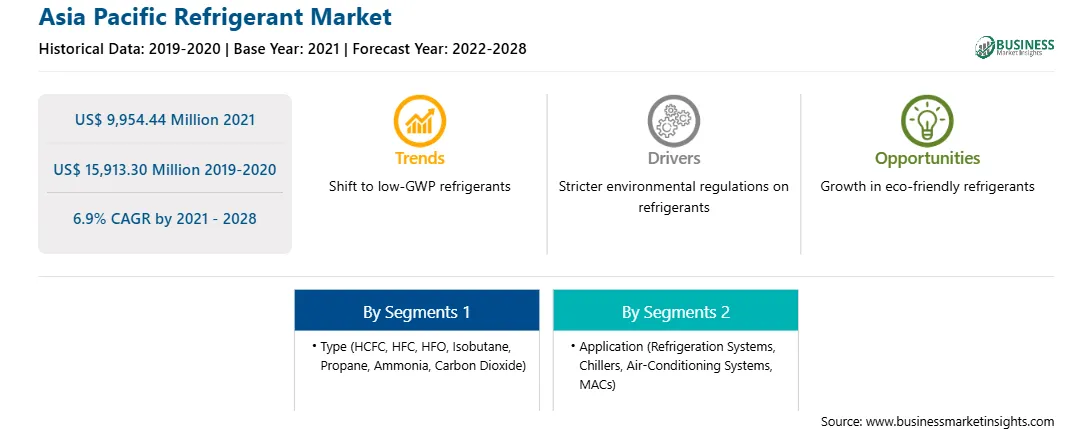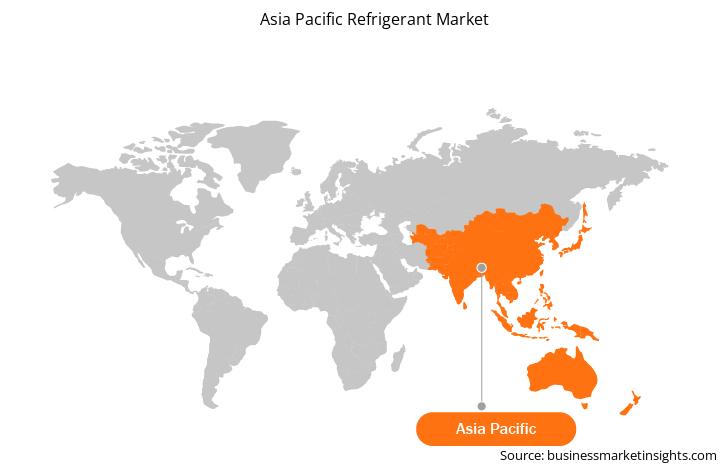An increase in global warming and the phase-out of fluorocarbon have led to a resurgence in demand for eco-friendly or natural refrigerants. In addition to the growing concerns about the adverse effects of fluorocarbon-based refrigerant exertions on the environment, low deployment costs, wide availability, high thermal conductivity and gas-phase density, a significant heat transfer rate, and reduced harmful effects are the key factors boosting the demand for eco-friendly refrigerants, such as ammonia and carbon dioxide. Moreover, regulations and compliance set by governing bodies mandate the discontinuation of many harmful fluorocarbon-based refrigerants in several Asia Pacific countries. Multinational companies in the field are increasingly investing in research and development to develop novel and eco-friendly offerings to ensure a sustainable business model. The mobile air conditioning directive and the F-gas regulation are the two legislative measures taken by several countries to support eco-friendly refrigerants. The mobile air conditioning directive prohibits the use of fluorinated gases in air conditioning systems. The F-gas regulation focuses on improving the leakage of fluorinated gases, avoiding the use of these gases, and using eco-friendly alternatives. Thus, the growing consumption of eco-friendly refrigerants is expected to fuel the refrigerant market growth across Asia Pacific in the coming years.
With innovative features and technologies, vendors can attract new customers and expand their footprints in emerging markets. This factor is likely to drive the APAC refrigerant market at a significant CAGR during the forecast period.
Strategic insights for the Asia Pacific Refrigerant provides data-driven analysis of the industry landscape, including current trends, key players, and regional nuances. These insights offer actionable recommendations, enabling readers to differentiate themselves from competitors by identifying untapped segments or developing unique value propositions. Leveraging data analytics, these insights help industry players anticipate the market shifts, whether investors, manufacturers, or other stakeholders. A future-oriented perspective is essential, helping stakeholders anticipate market shifts and position themselves for long-term success in this dynamic region. Ultimately, effective strategic insights empower readers to make informed decisions that drive profitability and achieve their business objectives within the market.

| Report Attribute | Details |
|---|---|
| Market size in 2021 | US$ 9,954.44 Million |
| Market Size by 2028 | US$ 15,913.30 Million |
| Global CAGR (2021 - 2028) | 6.9% |
| Historical Data | 2019-2020 |
| Forecast period | 2022-2028 |
| Segments Covered |
By Type
|
| Regions and Countries Covered | Asia-Pacific
|
| Market leaders and key company profiles |
The geographic scope of the Asia Pacific Refrigerant refers to the specific areas in which a business operates and competes. Understanding local distinctions, such as diverse consumer preferences (e.g., demand for specific plug types or battery backup durations), varying economic conditions, and regulatory environments, is crucial for tailoring strategies to specific markets. Businesses can expand their reach by identifying underserved areas or adapting their offerings to meet local demands. A clear market focus allows for more effective resource allocation, targeted marketing campaigns, and better positioning against local competitors, ultimately driving growth in those targeted areas.

APAC Refrigerant Market Segmentation
The APAC refrigerant market is segmented based on type, application, and country. Based on type, APAC refrigerant market is segmented into HCFC, HFC, HFO, isobutane, propane, ammonia, carbon dioxide, and others. The HFC segment dominated the market in 2020 and ammonia segment is expected to be fastest growing during forecast period. Based on application, APAC refrigerant market is segmented into refrigeration system, chillers, air-conditioning systems, MACs, and others. The refrigeration system segment dominated the market in 2020 and air-conditioning systems segment is expected to be fastest growing during forecast period. Based on country, the APAC refrigerant market has been segmented into China, India, Japan, South Korea, Australia, and rest of APAC.
AGC Inc.; AIR LIQUIDE SA; Arkema; Daikin Industries, Ltd.; Dongyue Group; Honeywell International Inc.; LINDE; Sinochem Group Co. Ltd.; and The Chemours Company are among the leading companies in the APAC refrigerant market.
The Asia Pacific Refrigerant Market is valued at US$ 9,954.44 Million in 2021, it is projected to reach US$ 15,913.30 Million by 2028.
As per our report Asia Pacific Refrigerant Market, the market size is valued at US$ 9,954.44 Million in 2021, projecting it to reach US$ 15,913.30 Million by 2028. This translates to a CAGR of approximately 6.9% during the forecast period.
The Asia Pacific Refrigerant Market report typically cover these key segments-
The historic period, base year, and forecast period can vary slightly depending on the specific market research report. However, for the Asia Pacific Refrigerant Market report:
The Asia Pacific Refrigerant Market is populated by several key players, each contributing to its growth and innovation. Some of the major players include:
The Asia Pacific Refrigerant Market report is valuable for diverse stakeholders, including:
Essentially, anyone involved in or considering involvement in the Asia Pacific Refrigerant Market value chain can benefit from the information contained in a comprehensive market report.